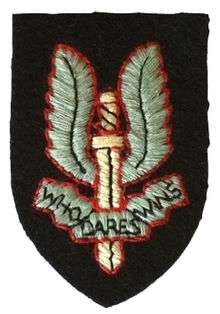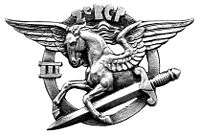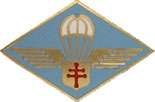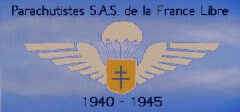2nd Parachute Chasseur Regiment
| 2nd Parachute Chasseur Regiment 2e Régiment de Chasseurs Parachutistes | |
|---|---|
 | |
| Active | 1943 - 1946 |
| Country |
|
| Branch | French Army |
| Type | Parachute Infantry |
| Role | Infantry |
| Motto(s) | « Who Dares Wins » |
| Engagements | |
| Insignia | |
| Abbreviation | 2e R.C.P |
The 2nd Parachute Chasseur Regiment (French: 2e Régiment de Chasseurs Parachutistes) or 2e RCP, is one of the most decorated French unit of Second World War. The unit is the only terrestrial unit to have been bestowed with the Red Fourragere during the world conflict including 6 citations at the orders of the armed forces.[1] The French Navy Submarine Casabianca accumulated similarly 6 citations at the orders of the armed forces and deep sail bore the same Fourragere.
The unit was commonly referred to in the British Army as the 4th SAS.
Creation and different nominations
- July 1, 1943 : creation of the 1st Air Infantry Battalion.
- November 1, 1943 : 4th Air Infantry Battalion.
- April 1, 1944 : redesignated 4th SAS Regiment or 2nd Parachute Chasseur Regiment 2e RCP for the French.
- September 30, 1946 : dissolution of the regiment.[2]
History, garrisons, campaigns and battles
World War II
Unit constitution formation
The 1st Air Infantry Battalion (1e B.I.A) was constituted on July 1, 1943 in camp of Old Dean at Camberley from volunteers and from the 1st Air Infantry Company and 2nd Air Infantry Company (1e C.I.A, 2e C.I.A); the 1st Air Infantry Company eC.I.A created by Captain Bergé and which notably illustrated capability in Crete, Tunisia and Libya, consequently gaining a citation at the orders of the Air Force;[3] and in essence formed on September 15, 1940.[4]
The battalion, integrated the Free French Air Forces and was entrusted to Commandant Pierre Fourcaud. The battalion counted then 398 men, spread in 4 combat companies. These men were fist parachute brevetted at the Central Landing Establishment (C.L.E) of Ringway.
The unit was redesignated as 4th Air Infantry Battalion 4e B.I.A on November 1, 1943 and passed over to the command of Commandant Pierre-Louis Bourgoin, a manchot with right arm amputated on February 1943 during a reconnaissance mission in Tunisia. The 4e B.I.A was joined with the 3rd Parachute Chasseur Regiment 3e RCP of Commandant Pierre Chateau-Jobert forming the corps of a Demi-Brigade commanded by Lieutenant-Colonel Durand.
It should be noted that many French volunteers followed a parachute formation at the Airportable Instruction Center of the 1st Independent Polish Parachute Brigade at Upper Largo, in Scotland, and where 244 Polish Parachute Brevets were warrantly commissioned.[5]
In April 1944, the B.I.As, who joined in December 1943 their British and Belgian homologues at the corps of the SAS Brigade of the Army Air Corps, were conferred their denomination and designation of regiments: the 3e and 4e B.I.A became respectively the 3rd and 4th SAS regiments for the British and a little later, the 3rd Parachute Chasseur Regiment 3e and 2nd Parachute Chasseur Regiments 2e for the French.
Operations in Bretagne

During the night of June 5 to 6 1944, four SAS (36 men) respectively under the orders of Lieutenants Marienne, Henri Deplante, Botella and Deschamps embarked in two quadrimoteurs Short Stirling of the Royal Air Force with destination, Bretagne. The first two teams were parachuted on the sector of Plumelec, 15 km of Maquis de Saint-Marcel, Morbihan. The two other teams in the wooden forest of Duault in the Côtes-d'Armor. Their mission was to establish guerilla bases code named respectively Operation Dingson and Operation Samwest.
Lieutenant Marienne's team was spotted. An important Georgian contingent encircled the team and during the accrochahe which would follow, corporal Emile Bouétard was wounded and killed. Caporal Bouétard would be the first military casualty of "Operation Overlord".
During the months of June and July, the SAS paratroopers led a wooden forest runners life. Often, they mounted brutal attacks and unfolded, often they camouflaged and blended with the forest to better intervene throughout the course of a more favorable opportunity. On the morning of June 18, the camp of the SAS and the resistance was attacked. Following a combat engagement, which lasted an entire day, the French succeeded in leaving Serent and Saint-Marcel by blowing up their ammunition depot. At dawn of July 12, an opposing contingents along with milicias managed to infiltrate until the command post of Lieutenant Marienne at Kerihuel, Plumelec where 18 men including: the paratroopers, maquis and farmers were apprehended. Finally, when on August 3, U.S. Armoured Brigades of General George S. Patton reached Rennes, inappropriate activities were brought to a halt. The 4th SAS regiment ( or 2e RCP ), endured the loss (killed, wounded and prisoners) 23 Officers and 195 men out of 50 Officers and 500 men ( 77 killed for the Liberation of Bretagne ).
End operations
SAS combats often have unexpected conclusions. At Montceau-les-Mines, a group of paratroopers and a fist section of the Free French Forces, made opposing forces, much more superior in numbers, believe that the effectif of a division was encircling them. Accordingly, they managed to recuperated hundreds of prisoners, tanks and cannons. At the end of the campaign, the 3rd Parachute Chasseur Regiment 3eRCP endured the loss of 80 out of 400 effectifs. In their time existence, the men's regiment placed thousands of opposing forces out of their combat element along with some 383 vehicles.
On Christmas Day 1944, the paratrooper of the SAS, operated in the Belgian Ardennes, within the cadre of the counter-offensive of Operation Von Runstedt. On November 11, 1944, the men of the 2nd Parachute Chasseur Regiment received from the hands of Général Charles de Gaulle the Croix de la Libération. The 2e RCP, which bore wearing the amaranth beret since September, paraded with the SAS insignia conceived for the first time.
On April 7, 1945, the two Parachute Chasseur Regiments regiments (counting 770 men) were parachuted on the Pays-Bas (Operation Amherst).
Post War
On August 1, 1945, the 3rd and 4th SAS Regiments, for the French 2nd and 3rd Parachute Chasseur Regiment, were transferred to the French Army. They both merged to form a unique 2nd Parachute Chasseur Regiment, 2eR.C.P which set garrison at Tarbes. On October 2, 1945, British général Michael Calvert commandant of the SAS Brigade, visited the regiments and bestowed on the 2e RCP their respective fanions as well the Napoleon chapeau and to the 3e RCP the Wellington chapeau, a sign of friendship and fraternity in arms.
The 2nd Parachute Chasseur Regiment 2e RCP was dissolved on September 30, 1946. A new 2e RCP ( not related to the SAS ) set formation and was seen entrusted with respective Regimental Colors and the Amaranth Beret. At dissolution, effectifs were ventilated between the 1st Parachute Chasseur Regiment and the 1st Choc Airborne Infantry Regiment 1er R.I.C.A.P, while the Regimental Colors was entrusted to the SAS Parachute Commando Demi-Brigade of Indochina. This Commando Demi-Brigade passed by the Colonial Troupes and became later, the 1st Marine Infantry Parachute Regiment, 1er R.P.I.Ma, which conserved the regimental colors, decorations and traditions of the 2nd Parachute Chasseur Regiment/SAS.
Traditions
Motto
« Who dares wins » is the general motto of the SAS, translated in French to « Qui ose gagne ».
Insignia
-

Para Chasseur Company of French French Forces (FFL).
-

Logo of the Free French Force SAS conserved for SAS paratroopers of Free France 1940-1945.
Honors
Battle honors
Painted in Golden letters in the folds, the regimental colors bear the following inscriptions:[6]
- Crète 1942
- Libye 1942
- Sud Tunisien 1943
- France 1944-1945
- Ardennes belges 1945
- Hollande 1945
- Indochine 1946-1954
Decorations
- Croix de la Légion d'Honneur
- Croix de Compagnon de la Libération
- Croix de guerre 1939-1945 with 6 palms
- Croix de Guerre belge
- Croix de Guerre néerlandaise
- Bronze Star Medal (U.S.)
Bears wearing :
- Fourragere bearing the colors of the Légion d'honneur (with olive 1939-45)
- Fourragère des T.O.E (Demi-brigade SAS Indochina)
- Fourragère de Compagnon de la Libération since June 18, 1996 ( received by the 1er R.P.I.Ma - the heir)
Regimental Commanders
- Captain François Coulet : 1942 (1st Air Infantry Battalion, 1er B.I.A)
- Capitaine Lambert : 1943 (1st Air Infantry Battalion, 1er B.I.A)
- Chef de bataillon Pierre Fourcaud : July 1943 (1st Air Infantry Battalion 1er B.I.A)
- Commandant Pierre-Louis Bourgoin : November 1943 (4th Air Infantry Battalion, 4e B.I.A)
- Commandant Pierre Puech-Samson : November 1944 (2e R.C.P)
- Lieutenant-colonel Jacques Pâris de Bollardière : August 1, 1945 (2e R.C.P)
- Colonel Reynier : 1945 (2e R.C.P - non.SAS)
Notable members of the 2nd Parachute Chasseur Regiment
- Lucien Neuwirth
- Jacques Bouffartigue
See also
References
- ↑ In Chasseurs Parachutistes 1935-2005 page 295.
- ↑ Ces dates proviennent pour la plupart du livre de Pierre Dufour, Chasseurs Parachutistes 1935-2005 pages 16
- ↑ Chasseurs Parachutistes 1935-2005 page 31
- ↑ In Chasseurs Parachutistes 1935-2005 pages 28 et 36.
- ↑ Michel (2016-05-20). "FAFL > - Les Fusiliers Commandos de l'Air". Commando-air.fr. Retrieved 2016-09-11.
- ↑ Décision n°12350/SGA/DPMA/SHD/DAT du 14 septembre 2007 relative aux inscriptions de noms de batailles sur les drapeaux et étendards des corps de troupe de l'armée de terre, du service de santé des armées et du service des essences des armées, Bulletin officiel des armées, n°27, 9 novembre 2007
Sources and bibliography
- Collectif, Histoire des parachutistes français, Société de Production Littéraire, 1975.
- Qui ose gagne (France-Belgique 1943-1945, les parachutistes du 2e RCP / 4th SAS Service historique de l'armée de terre, 1997, page 296, ISBN 978-2863231036
- Les Bérets Rouges, Amicale des Anciens Parachutistes S.A.S., 1952, page 329
- Pierre Dufour, Chasseurs Parachutistes 1935-2005, éditions Lavauzelle, 2005 - ISBN 2-7025-1287-9.
- Roger Flamand, Paras de la France libre, Éditions Presses de la Cité, 1976 - ISBN 978-2-258-00036-0.
- Olivier Porteau, L’Action combinée du 2e régiment de chasseurs parachutistes et de la Résistance bretonne dans le dispositif stratégique de l’opération Overlord, in Patrick Harismendy et Erwan Le Gall (dir.), Pour une histoire de la France Libre, Presses Universitaires de Rennes, 2012, p. 107-123
- David Portier, Les Parachutistes SAS de la France Libre 1940-1945, Éditions Nimrod, septembre 2010
- Esquisse d’un bilan réévalué de l’action des parachutistes français en Bretagne : mission militaire et/ou politique ? Revue d'histoire contemporaine en Bretagne, n°2, été 2013, article en ligne
- Serge Vaculik, Béret rouge - Scènes de la vie des commandos parachutistes S.A.S., Éditions Arthaud, 1952.
- Franck Segrétain, Opération Amherst, avril 1945 le raid des 2e et 3e RCP sur les pays bas. Revue Ligne de front n° 24, mai-juin 2010. ISSN 1953-0544
External links
- Historique du 4e SAS sur le site France libre
- Site consacré aux parachutistes SAS de la France Libre 1940 - 1945
- Historique du 2e RCP sur le site de l'ordre de la libération